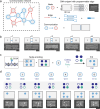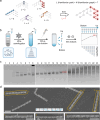Artificial molecular communication network based on DNA nanostructures recognition
- PMID: 39747880
- PMCID: PMC11696045
- DOI: 10.1038/s41467-024-55527-w
Artificial molecular communication network based on DNA nanostructures recognition
Abstract
Artificial simulated communication networks inspired by molecular communication in organisms use biological and chemical molecules as information carriers to realize information transmission. However, the design of programmable, multiplexed and general simulation models remains challenging. Here, we develop a DNA nanostructure recognition-based artificial molecular communication network (DR-AMCN), in which rectangular DNA origami nanostructures serve as nodes and their recognition as edges. After the implementation of DR-AMCN with various communication mechanisms including serial, parallel, orthogonal, and multiplexing, it is applied to construct various communication network topologies with bus, ring, star, tree, and hybrid structures. By the establishment of a node partition algorithm for path traversal based on DR-AMCN, the computational complexity of the seven-node Hamiltonian path problem is reduced with the final solution directly obtained through the rate-zonal centrifugation method, and scalability of this approach is also demonstrated. The developed DR-AMCN enhances our understanding of signal transduction mechanisms, dynamic processes, and regulatory networks in organisms, contributing to the solution of informatics and computational problems, as well as having potential in computer science, biomedical engineering, information technology and other related fields.
© 2024. The Author(s).
Conflict of interest statement
Competing interests: The authors declare no competing interests.
Figures






Similar articles
-
Fast parallel DNA-based algorithms for molecular computation: the set-partition problem.IEEE Trans Nanobioscience. 2007 Dec;6(4):346-53. doi: 10.1109/tnb.2007.909012. IEEE Trans Nanobioscience. 2007. PMID: 18217628
-
A new parallel DNA algorithm to solve the task scheduling problem based on inspired computational model.Biosystems. 2017 Dec;162:59-65. doi: 10.1016/j.biosystems.2017.09.001. Epub 2017 Sep 7. Biosystems. 2017. PMID: 28890344
-
Building DNA nanostructures for molecular computation, templated assembly, and biological applications.Acc Chem Res. 2014 Jun 17;47(6):1778-88. doi: 10.1021/ar500023b. Epub 2014 Apr 10. Acc Chem Res. 2014. PMID: 24720350
-
Spatially-interactive biomolecular networks organized by nucleic acid nanostructures.Acc Chem Res. 2012 Aug 21;45(8):1215-26. doi: 10.1021/ar200295q. Epub 2012 May 29. Acc Chem Res. 2012. PMID: 22642503 Free PMC article. Review.
-
Engineering nucleic acid structures for programmable molecular circuitry and intracellular biocomputation.Nat Chem. 2017 Nov;9(11):1056-1067. doi: 10.1038/nchem.2852. Epub 2017 Sep 25. Nat Chem. 2017. PMID: 29064489 Free PMC article. Review.
Cited by
-
Analyzing Molecular Determinants of Nanodrugs' Cytotoxic Effects.Int J Mol Sci. 2025 Jul 11;26(14):6687. doi: 10.3390/ijms26146687. Int J Mol Sci. 2025. PMID: 40724938 Free PMC article.
-
DNA Nanostructures for Rational Regulation of Cellular Organelles.JACS Au. 2025 Mar 26;5(4):1591-1616. doi: 10.1021/jacsau.5c00117. eCollection 2025 Apr 28. JACS Au. 2025. PMID: 40313805 Free PMC article. Review.
References
-
- Yu, J. X. & Li, H. Convolutional codec implemented by genetic circuits for molecular communication. IEEE Trans. Nanobiosci.22, 78–91 (2023). - PubMed
-
- El-atty, Abd et al. Engineering molecular communications integrated with carbon nanotubes in neural sensor nanonetworks. IET Nanobiotechnol.12, 201–210 (2018).
-
- Nakano, T. et al. Performance evaluation of leader-follower-based mobile molecular communication networks for target detection applications. IEEE Trans. Commun.65, 663–676 (2017).
-
- Chahibi, Y. et al. Propagation modeling and analysis of molecular motors in molecular communication. IEEE Trans. Nanobiosci.15, 917–927 (2016). - PubMed
-
- Bayraktar, Y. et al. Analyzing of alzheimer’s disease based on biomedical and socio-economic approach using molecular communication, artificial neural network, and random forest models. Sustainability14, 7901 (2022).
Publication types
MeSH terms
Substances
Grants and funding
LinkOut - more resources
Full Text Sources

